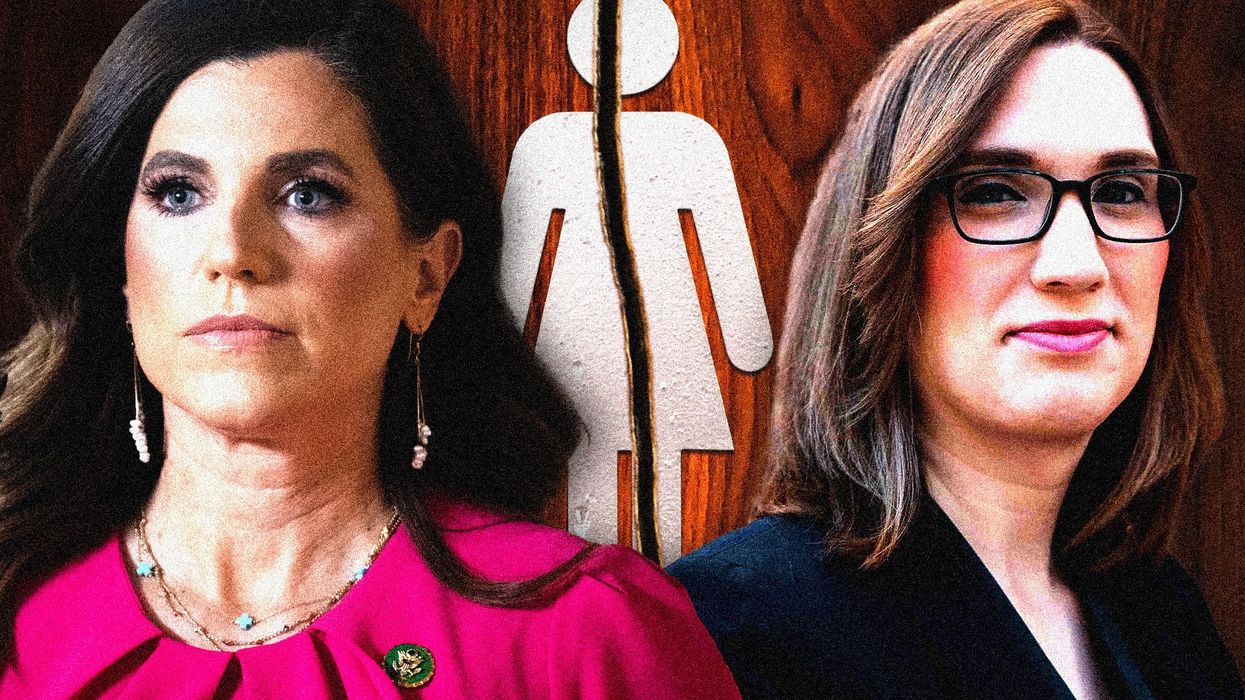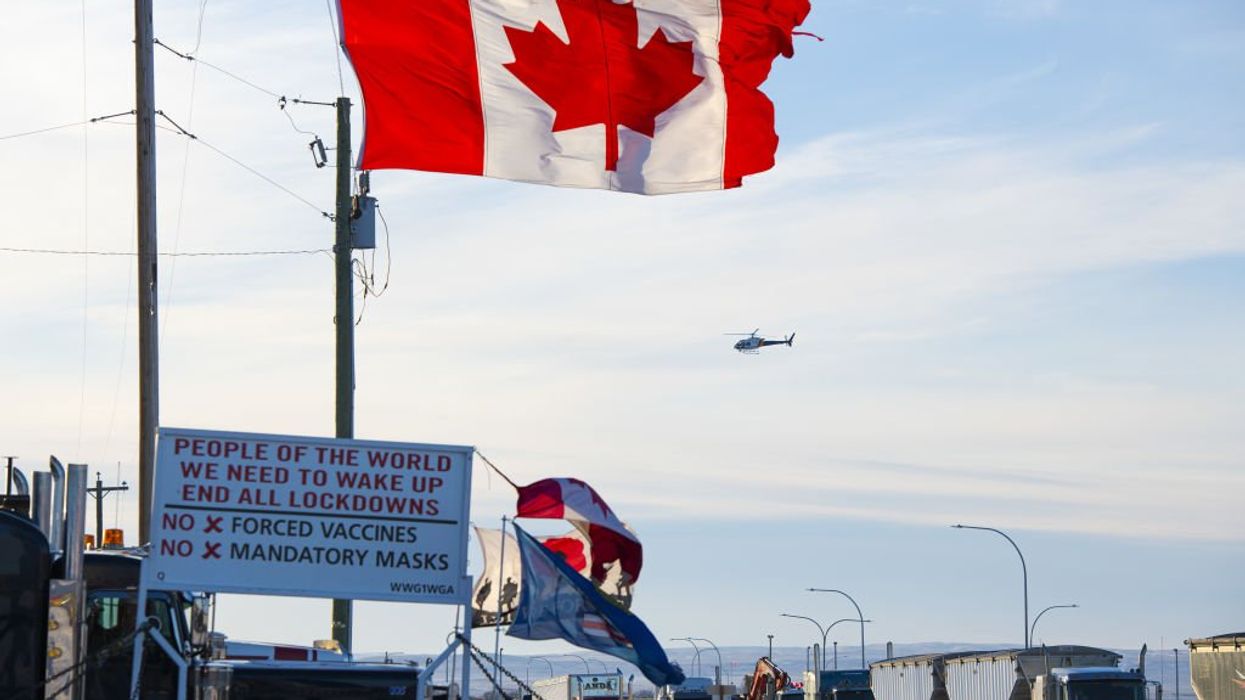VATICAN CITY (TheBlaze/AP) — The Catholic Church will make history Sunday, with Pope Francis presiding over the first dual papal canonization in history. Popes John XXIII and John Paul II -- pontiffs who both served in the modern era -- will officially be declared saints.
While much coverage has surrounded the event, the ceremony, itself, is likely to be quick and surprisingly straightforward (though much of the event will be in Latin, making it difficult to understand for most who don't know the language).
Below, there are seven things you probably want to know about the canonization process and tomorrow's historic event:
--
1) How Does One Become a Saint?
Before we dive into tomorrow's ceremony, let's quickly examine how a person becomes a saint in the Catholic faith.
"The process for being declared a saint is ancient, traditional, and often mysterious," explains the For Dummies website (the site offers a wonder primer on sainthood). "Evidence must be presented to persuade Church officials that the person in question in fact lived a virtuous life, had faith, and had the support and help of God."
 FILE - In this April 15, 1963 file photo, Pope John XXIII sits at his working desk in his studio in a IX century tower in the Vatican gardens. In background the dome of St. Peter's Basilica. (AP Photo/Luigi Felici, File)
FILE - In this April 15, 1963 file photo, Pope John XXIII sits at his working desk in his studio in a IX century tower in the Vatican gardens. In background the dome of St. Peter's Basilica. (AP Photo/Luigi Felici, File)
The Catholic Church goes through a long process of verification, in which the person's sermons and actions are heavily scrutinized, with his reputation and earthly duties examined to ensure that he is worthy of canonization.
Investigators also look at miracles that God has performed through the person's life. Generally speaking, two miracles are required in order for someone to be considered for sainthood.
2) Miracles
While some might assume that miracles are easy to come by, the Catholic Church goes through a long verification process in which physicians explore the claims of those who say they've been cured by individuals being considered for sainthood.
And not just any claim is taken at face value. There's an organized, methodical way of exploring whether there's legitimacy to claims of the miraculous.
"Only immediate, spontaneous, and inexplicable phenomena are up for consideration as authentic miracles," Dummies explains. "A group of Italian doctors (Consulta Medica) examine the healing miracles. Some of the doctors aren’t Catholic and some are, but all are qualified and renowned physicians. They don’t declare a healing a miracle, but instead say, 'We can find no scientific or medical explanation for the cure.'"
In the case of Pope John Paul II, a woman named Floribeth Mora, a grandmother and the mother of three children, has gained international fame for claiming that the pontiff helped save her life.
 Images depicting the late Pope John Paul II and Pope John XXIII hang in a shop near St Peter's Basilica on April 25, 2014 in Vatican City, Vatican. Dignitaries, heads of state and Royals, from Europe and across the World, are gathering in the Vatican ahead of tomorrows canonizations. (Dan Kitwood/Getty Images)
Images depicting the late Pope John Paul II and Pope John XXIII hang in a shop near St Peter's Basilica on April 25, 2014 in Vatican City, Vatican. Dignitaries, heads of state and Royals, from Europe and across the World, are gathering in the Vatican ahead of tomorrows canonizations. (Dan Kitwood/Getty Images)
Mora was on her deathbed, suffering from an incurable brain aneurysm in 2011 when she says something profound happened: her inoperable aneurysm purportedly disappeared in the blink of an eye, what she believes is the result of a God-ordained miracle.
After being sent home in April 2011 with medication to treat the aneurysm, Mora thought she would die. But then she claims a photograph of the pope helped heal her. When she looked at the picture while laying in bed one day, Mora claims she heard the following words: “Stand up. Don’t be afraid.” Then, the aneurysm disappeared.
The second less publicized miracle involved a French nun named Marie Simon Pierre, 47, who said her symptoms of Parkinson's disease disappeared after she prayed to the pontiff following his death, according to ABC News.
As for Pope John XXIII, there's something important to note: he has only one verified miracle attributed to him, a unique development, seeing as two are generally required. He is apparently seen as holy enough to be canonized without the need for a second miracle.
The pontiff's one verified miracle involved the curing of a Sister Caterina Capitani, a nun who was suffering a severe gastric illness in 1966 (read more about it here). Doctors said her healing was inexplicable and she credited the late pope.
3) What to Expect at Tomorrow's Ceremony
Most people are likely curious to know what goes into a canonization ceremony. The preliminary part of the event will begin at around 0700 GMT (2 a.m. ET) with prayers, hymns and culminates with the chanting of the hypnotic Litany of Saints, the roll call of the church's saints, each one followed by the refrain "Ora pro nobis," or "Pray for us."
 A woman enters a curtain between the images of Pope John Paul II and Pope John XXIII as Archbishop of Krakow and former personal secretary of the late Pope John Paul II Stanislaw Dziwisz, Pope Francis' spokesman Father Federico Lombardi and Don Ezio Bolis attend a press conference on the Canonization of Pope John Paul II and Pope John XXIII at the Vatican Media Center in the Paul VI Hall on April 25, 2014 in Vatican City, Vatican. (Franco Origlia/Getty Images)
A woman enters a curtain between the images of Pope John Paul II and Pope John XXIII as Archbishop of Krakow and former personal secretary of the late Pope John Paul II Stanislaw Dziwisz, Pope Francis' spokesman Father Federico Lombardi and Don Ezio Bolis attend a press conference on the Canonization of Pope John Paul II and Pope John XXIII at the Vatican Media Center in the Paul VI Hall on April 25, 2014 in Vatican City, Vatican. (Franco Origlia/Getty Images)
After the pope and concelebrants process to the altar, the canonization rite begins immediately. The head of the Vatican's saint-making office, Cardinal Angelo Amato, asks the pope three separate times to include John XXIII and John Paul II among the saints.
In the rite for beatification, there is only one such petition. The three repeated requests for canonization "signify the importance of this celebration," noted the Vatican spokesman the Rev. Federico Lombardi.
A brief side note: There is a difference between beatification and canonization, with the former more of a localized event and the latter a celebration centered at the Vatican and the Catholic Church as a whole. Catholic News Service has more:
During a beatification ceremony, the bishop of the diocese where the person dies asks that the candidate be declared blessed; at a canonization, the prefect of the Congregation for Saints' Causes speaks in the name of the whole church and asks that the candidate be declared a saint. [...]
Beatification is an "administrative act" by which the pope allows a candidate for sainthood to be venerated publicly in places closely associated with his or her life and ministry; the place may be as small as one city, although usually it is the diocese where the person lived or died. [...]
A canonization, on the other hand, is a formal papal decree that the candidate was holy and is now in heaven with God; the decree allows public remembrance of the saint at liturgies throughout the church. It also means that churches can be dedicated to the person without special Vatican permission.
So, there you have it. The two are similar, but not the same. Read more about that here.
4) The Pronouncement
Pope Francis will make a pronouncement at tomorrow's event that will lead to official sainthood for Popes John Paul II and John XXIII -- a proclamation that is pretty straightforward and brief.
After the three petitions, the pontiff will say:
"For the honor of the Blessed Trinity, the exaltation of the Catholic faith and the increase of the Christian life, by the authority of our Lord Jesus Christ, and of the holy Apostles Peter and Paul, and our own, after due deliberation and frequent prayer for divine assistance, and having sought the counsel of many of our brother bishops, we declare and define Blessed John XXIII and John Paul II be saints and we enroll them among the saints, decreeing that they are to be venerated as such by the whole church. In the name of the Holy Father, and of the Son, and of the Holy Spirit."
 A nun takes a photo as she and others walk towards St. Peter's Basilica at the Vatican, Saturday, April 26, 2014. Pilgrims and faithful are gathering in Rome to attend Sunday's ceremony at the Vatican where Pope Francis will elevate in a solemn ceremony John XXIII and John Paul II to sainthood. (AP Photo/Emilio Morenatti)
A nun takes a photo as she and others walk towards St. Peter's Basilica at the Vatican, Saturday, April 26, 2014. Pilgrims and faithful are gathering in Rome to attend Sunday's ceremony at the Vatican where Pope Francis will elevate in a solemn ceremony John XXIII and John Paul II to sainthood. (AP Photo/Emilio Morenatti)
What comes next are relics, which are brought to the altar as part of the fascinating ceremony.
5) The Relics You Can Expect at Tomorrow's Event
In the case of John Paul, the same relic -- blood -- used for his 2011 beatification is being used. For John XXIII, some skin taken when his body was exhumed for his 2000 beatification is being used.
Amato then thanks Francis and asks him to draw up an official document attesting to the canonization. Francis responds "We so decree" and the rite ends with the singing of "Gloria."
The Mass then proceeds as usual.
6) The Audience
A massive crowd will head to the Vatican to observe the festivities surrounding the canonizations. But in addition to the general public, 93 official delegations plan to attend, including an estimated 24 heads of state.
Thus, royalty and powerful leaders will come together to celebrate Pope John Paul II and John XXIII, with the kings and queens of Belgium and Spain, royals from Andorra, Britain and Luxemburg expected to attend.
Poland is sending one of the largest delegations with the current president and two former presidents, including Lech Walesa, founder of the Solidarity movement that toppled communism in Poland, which John Paul supported.
Faith leaders will also attend, with between 130-150 cardinals and 1,000 bishops officiating and celebrating the Mass along with Pope Francis.
Additionally, some 6,000 priests will join them sitting up front near the altar of St. Peter's Square. And about 600 priests will distribute Communion in St. Peter's Square and 210 deacons will distribute Communion to the throngs of people expected to line up along Via della Conciliazione, the main boulevard leading away from the square.
 Pilgrims sit and rest in front of St. Peter's Basilica at the Vatican, Saturday, April 26, 2014. Pilgrims and faithful are gathering in Rome to attend Sunday's ceremony at the Vatican where Pope Francis will elevate in a solemn ceremony John XXIII and John Paul II to sainthood. (AP Photo/Emilio Morenatti)
Pilgrims sit and rest in front of St. Peter's Basilica at the Vatican, Saturday, April 26, 2014. Pilgrims and faithful are gathering in Rome to attend Sunday's ceremony at the Vatican where Pope Francis will elevate in a solemn ceremony John XXIII and John Paul II to sainthood. (AP Photo/Emilio Morenatti)
Let's remember, too, that emeritus Pope Benedict XVI will likely attend, adding yet another fascinating and historical element to the canonization, as two pontiffs will be in attendance.
7) Virtual Canonization
Can't make the actual ceremony? No worries. You'll be able to watch it on television and follow it online here and here.
—

 FILE - In this April 15, 1963 file photo, Pope John XXIII sits at his working desk in his studio in a IX century tower in the Vatican gardens. In background the dome of St. Peter's Basilica. (AP Photo/Luigi Felici, File)
FILE - In this April 15, 1963 file photo, Pope John XXIII sits at his working desk in his studio in a IX century tower in the Vatican gardens. In background the dome of St. Peter's Basilica. (AP Photo/Luigi Felici, File)
 Images depicting the late Pope John Paul II and Pope John XXIII hang in a shop near St Peter's Basilica on April 25, 2014 in Vatican City, Vatican. Dignitaries, heads of state and Royals, from Europe and across the World, are gathering in the Vatican ahead of tomorrows canonizations. (Dan Kitwood/Getty Images)
Images depicting the late Pope John Paul II and Pope John XXIII hang in a shop near St Peter's Basilica on April 25, 2014 in Vatican City, Vatican. Dignitaries, heads of state and Royals, from Europe and across the World, are gathering in the Vatican ahead of tomorrows canonizations. (Dan Kitwood/Getty Images)
 A woman enters a curtain between the images of Pope John Paul II and Pope John XXIII as Archbishop of Krakow and former personal secretary of the late Pope John Paul II Stanislaw Dziwisz, Pope Francis' spokesman Father Federico Lombardi and Don Ezio Bolis attend a press conference on the Canonization of Pope John Paul II and Pope John XXIII at the Vatican Media Center in the Paul VI Hall on April 25, 2014 in Vatican City, Vatican. (Franco Origlia/Getty Images)
A woman enters a curtain between the images of Pope John Paul II and Pope John XXIII as Archbishop of Krakow and former personal secretary of the late Pope John Paul II Stanislaw Dziwisz, Pope Francis' spokesman Father Federico Lombardi and Don Ezio Bolis attend a press conference on the Canonization of Pope John Paul II and Pope John XXIII at the Vatican Media Center in the Paul VI Hall on April 25, 2014 in Vatican City, Vatican. (Franco Origlia/Getty Images)
 A nun takes a photo as she and others walk towards St. Peter's Basilica at the Vatican, Saturday, April 26, 2014. Pilgrims and faithful are gathering in Rome to attend Sunday's ceremony at the Vatican where Pope Francis will elevate in a solemn ceremony John XXIII and John Paul II to sainthood. (AP Photo/Emilio Morenatti)
A nun takes a photo as she and others walk towards St. Peter's Basilica at the Vatican, Saturday, April 26, 2014. Pilgrims and faithful are gathering in Rome to attend Sunday's ceremony at the Vatican where Pope Francis will elevate in a solemn ceremony John XXIII and John Paul II to sainthood. (AP Photo/Emilio Morenatti)
 Pilgrims sit and rest in front of St. Peter's Basilica at the Vatican, Saturday, April 26, 2014. Pilgrims and faithful are gathering in Rome to attend Sunday's ceremony at the Vatican where Pope Francis will elevate in a solemn ceremony John XXIII and John Paul II to sainthood. (AP Photo/Emilio Morenatti)
Pilgrims sit and rest in front of St. Peter's Basilica at the Vatican, Saturday, April 26, 2014. Pilgrims and faithful are gathering in Rome to attend Sunday's ceremony at the Vatican where Pope Francis will elevate in a solemn ceremony John XXIII and John Paul II to sainthood. (AP Photo/Emilio Morenatti)


